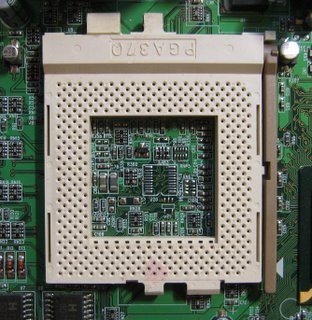
The term CPU socket (or CPU slot) is widely used to describe the connector linking the motherboard to the CPU(s) in certain types of desktop and server computers, particularly those compatible with the Intel x86 architecture.
Most CPU sockets and processors in use today are built around the pin grid array (PGA) architecture, in which the pins on the underside of the processor are inserted into the socket, usually with zero insertion force (ZIF) to aid installation. In contrast to this, several current and upcoming sockets use a land grid array (LGA) in which the pins are on the socket side instead and come in contact with pads on the processor. Slot based processors are cartridge shaped and fix into a slot that looks similar to expansion slots.
List of sockets and slots
Sockets
Socket 1 - 80486
Socket 2 - 80486
Socket 3 - 80486 (3.3 V and 5 V) and compatibles
Socket 4 - Intel Pentium 60/66 MHz
Socket 5 - Intel Pentium 75-133 MHz; AMD K5; IDT WinChip C6, WinChip 2
Socket 6 - 80486
Socket 7 - Intel Pentium, Pentium MMX; AMD K6
Super Socket 7 - AMD K6-2, AMD K6-III; Rise mP6
Socket 8 - Intel Pentium Pro
Socket 370 - Intel Pentium III, Celeron; Cyrix III; VIA C3
Socket 423 - Intel Pentium 41 Willamette core
Socket 463 (also known as Socket NexGen) - NexGen Nx586
Socket 478 - Intel Pentium 4, Celeron, Pentium 4 Extreme Edition1
Socket 479 - Intel Pentium M, Celeron M, Core Duo, & Core Solo
Socket 486 - 80486
Socket 499 - DEC Alpha 21164a
Socket 563 - AMD low-power mobile Athlon XP-M (µ-PGA Socket, mostly mobile parts)
Socket 603 - Intel Xeon
Socket 604 - Intel Xeon
Socket 754 - AMD single-processor systems using single-channel DDR-SDRAM, including AMD Athlon 64, Sempron, Turion 64
LGA 771 (also known as Socket 771) - Intel Xeon
Socket T (also known as LGA 775 or Socket 775) - Intel Pentium 4, Pentium D, Celeron D, Pentium Extreme Edition, Core 2 Duo, Core 2 Extreme, Celeron1
Socket 939 - AMD single-processor systems using dual-channel DDR-SDRAM, including Athlon 64, Athlon 64 FX to 1 GHz2, Athlon 64 X2, Opteron 100-series
Socket 940 - AMD single and multi-processor systems using DDR-SDRAM, including AMD Opteron 2, Athlon 64 FX
Socket A (also known as Socket 462) - AMD Athlon, Duron, Athlon XP, Athlon XP-M, Athlon MP, and Sempron
Socket F (also known as Socket 1207) - AMD multi-processor systems using DDR2-SDRAM, including AMD Opteron2, replaces Socket 940
Socket AM2 - AMD single-processor systems using DDR2-SDRAM, replaces Socket 754 and Socket 9392
Socket 4x4 - Future AMD dual-processor systems using DDR2-SDRAM, allows two dual-core microprocessors side by side (2x AM2 sockets or 2x 1207-pin socket F are rumoured).
Socket P - Future Intel-based, replaces Socket 479 for notebooks (Expected 2007)
Socket S1 - AMD-based mobile platforms using DDR2-SDRAM, replaces Socket 754 in the mobile sector
PAC418 - Intel Itanium
PAC611 - Intel Itanium 2, HP PA-RISC 8800 and 8900
Socket M - Intel Core Solo, Intel Core Duo, Intel Dual-Core Xeon and Intel Core 2 Duo
Slots
Slot 1 - Intel Celeron, Pentium II, Pentium III
Slot 2 - Intel Pentium II Xeon, Pentium III Xeon
Slot A - AMD Athlon
Slot B - DEC Alpha
Slotkets - adapters for using socket processors in bus-compatible slot motherboards
1: The 478 pin socket was introduced because it uses a micro-PGA layout which is physically smaller than the socket 423. Socket 775 was introduced with support for PCI express, DDR2 memory and Intel's version of the AMD64 processor extensions (called EM64T), but also moved to the new Land Grid Array physical layout, where the pins are in the socket rather than on the CPU package, for better electrical performance.
2: These sockets are for CPUs with integrated memory controllers. The 754 pin models have a single memory channel routed through the CPU pins. The 939 pin models have two memory channels, hence the higher pin count. The 940 pin CPUs also have two memory channels but they require registered memory, and most have support for SMP. Sockets F and AM2 are redesigned to support DDR2. The Socket F contains 1207 pins (Added pins speculated to be for more scalability and better power distribution. Socket AM2 has 940 pin-holes but does not support current AMD Opteron processors.
3: The slot packages had two advantages; L2 cache could be installed on the processor package but on a separate piece of silicon, and insertion and removal is simpler and easier. However, it lengthens the path of the traces from the CPU to the chipset and so became unsuitable as clock speeds increased past around 500 MHz. They were therefore abandoned and replaced with Socket A/Socket 370.

No comments:
Post a Comment